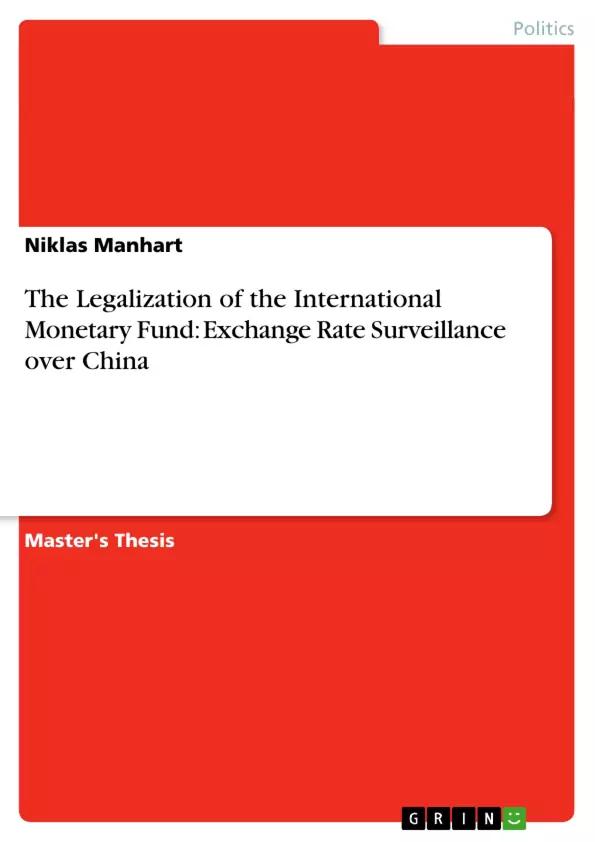Against the backdrop of the renminbi issue, this paper retraces the unique trajectory of the international law (IL) on exchange rates – from the lawlessness of the gold standard to a highly regulated system under Bretton Woods and back to the obscure arrangement that has prevailed ever since the Second Amendment of the IMF's Articles of Agreement. By employing the concept of legalization, it argues that international monetary stability is a public good which, as a collective action problem, provides strong incentives for cooperation. However, the analysis of the IMF's bilateral surveillance regime reveals that after the Second Amendment hard legalization no longer served the interests of the IMF membership, while the costs of hard legal rules tipped the scale in favour of soft commitments. Specifically, the paper finds that exchange rates are subject to high uncertainty costs stemming from measurement difficulties, complexity, goal incongruence and subjectivity; as well as sover-eignty costs due to reputational damage, distributional impact and loss of monetary power.
Inhaltsverzeichnis (Table of Contents)
- Introduction
- The role of law in monetary affairs.
- The principle of monetary sovereignty.
- The need for cooperation in international monetary relations_
- Limiting monetary sovereignty: the Articles of Agreement
- Unprecedented legality: 1945 to 1971
- Reforming the Articles: 1971 to 1978.
- Back to sovereignty: 1978 onwards.
- The IMF in today's international monetary system
- Bilateral surveillance of exchange rate policies.
- The original bilateral surveillance regime
- The amended Article IV
- The 1977 Decision
- The reformed bilateral surveillance regime: the 2007 Decision
- Formal sanctioning powers...
- The original bilateral surveillance regime
- The legalization of bilateral surveillance….
- Exchange rate surveillance in practice: the case of China
- The choice for soft legalization in exchange rate surveillance
- The future of exchange rate surveillance..
- Learning from the Fund: a constructivist perspective_
- Theory.
- Reality.
- The potential of Article IV consultations_
- Lessons learned? The IMF as a standard-setter
- Standards in the international financial architecture
- The track record on IMF standards
- The characteristics of effective surveillance
- Learning from the Fund: a constructivist perspective_
- Concluding remarks
Zielsetzung und Themenschwerpunkte (Objectives and Key Themes)
This work examines the role of international law in the regulation of exchange rate policies. It specifically focuses on the legalization of the IMF's bilateral surveillance regime, exploring the evolution of the regime and its effectiveness in practice.- The impact of international law on national monetary sovereignty.
- The evolution and effectiveness of the IMF's bilateral surveillance regime.
- The role of the IMF in setting standards for exchange rate policies.
- The case study of China and its exchange rate policies.
- The challenges of balancing sovereignty and international cooperation in monetary affairs.
Zusammenfassung der Kapitel (Chapter Summaries)
- Chapter 1: Introduction: This chapter sets the stage by introducing the topic of exchange rate surveillance and the challenges of international monetary cooperation. It discusses the conflicting interests of national sovereignty and the need for global economic stability.
- Chapter 2: The role of law in monetary affairs: This chapter explores the historical evolution of international law in monetary affairs, examining the principle of monetary sovereignty, the need for international cooperation, and the role of the IMF in limiting national sovereignty through the Articles of Agreement.
- Chapter 3: Bilateral surveillance of exchange rate policies: This chapter analyzes the original and reformed bilateral surveillance regimes, outlining the IMF's instruments and processes for monitoring member countries' exchange rate policies.
- Chapter 4: The legalization of bilateral surveillance…: This chapter delves into the concept of legalization and its application to the IMF's surveillance regime, exploring the extent to which the regime has become legally binding and enforceable.
- Chapter 5: Exchange rate surveillance in practice: the case of China: This chapter examines the controversy surrounding China's exchange rate policies, analyzing the IMF's surveillance of China and the challenges of achieving effective surveillance in practice.
- Chapter 6: The choice for soft legalization in exchange rate surveillance: This chapter explores the reasons behind the choice for soft legalization in the IMF's exchange rate surveillance regime, analyzing the costs and benefits of different levels of legalization.
- Chapter 7: The future of exchange rate surveillance..: This chapter discusses the potential for future developments in exchange rate surveillance, exploring the role of the IMF as a standard-setter and the characteristics of effective surveillance.
Schlüsselwörter (Keywords)
The text explores the intersection of international law, monetary sovereignty, and global economic stability. It examines the IMF's role in exchange rate surveillance, specifically focusing on the legalization of the bilateral surveillance regime, the challenges of achieving effective surveillance, and the potential for future developments. Key terms include: exchange rate policies, bilateral surveillance, international monetary system, IMF, Articles of Agreement, legalization, sovereignty, China, renminbi, and international financial architecture.- Citar trabajo
- M.A. Niklas Manhart (Autor), 2011, The Legalization of the International Monetary Fund: Exchange Rate Surveillance over China, Múnich, GRIN Verlag, https://www.grin.com/document/206705



